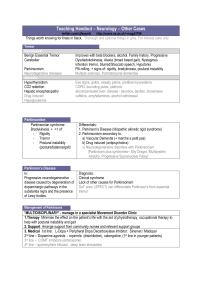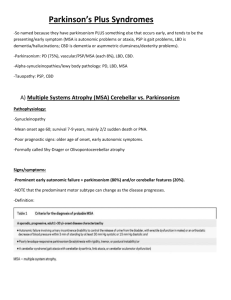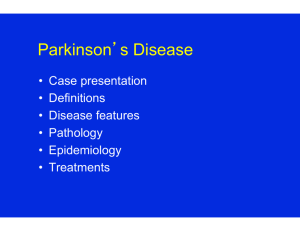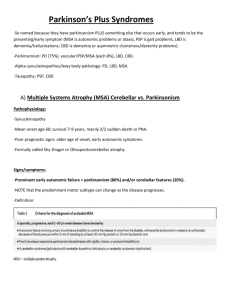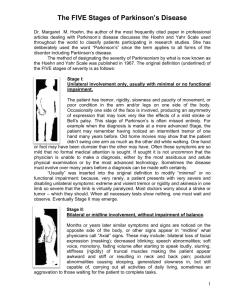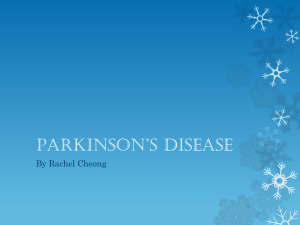23 Clinical Diagnosis of Vascular Parkinsonism and Nondegenerative Atypical Parkinsonian Disorders
advertisement
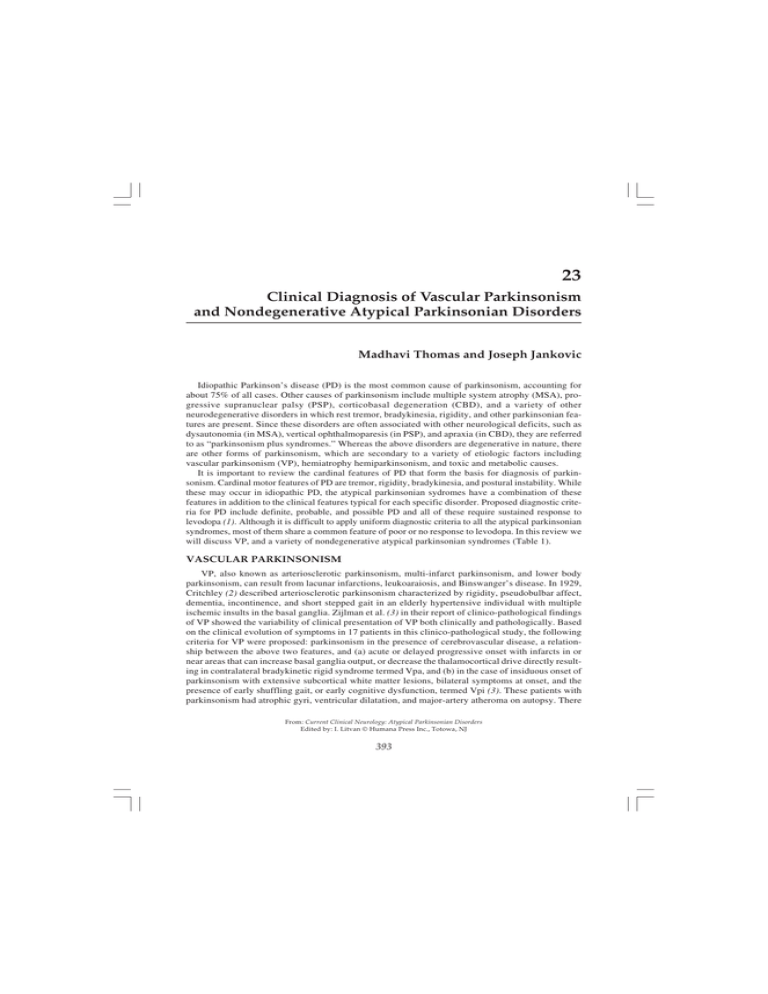
Clinical Diagnosis of Vascular Parkinsonism 393 23 Clinical Diagnosis of Vascular Parkinsonism and Nondegenerative Atypical Parkinsonian Disorders Madhavi Thomas and Joseph Jankovic Idiopathic Parkinson’s disease (PD) is the most common cause of parkinsonism, accounting for about 75% of all cases. Other causes of parkinsonism include multiple system atrophy (MSA), progressive supranuclear palsy (PSP), corticobasal degeneration (CBD), and a variety of other neurodegenerative disorders in which rest tremor, bradykinesia, rigidity, and other parkinsonian features are present. Since these disorders are often associated with other neurological deficits, such as dysautonomia (in MSA), vertical ophthalmoparesis (in PSP), and apraxia (in CBD), they are referred to as “parkinsonism plus syndromes.” Whereas the above disorders are degenerative in nature, there are other forms of parkinsonism, which are secondary to a variety of etiologic factors including vascular parkinsonism (VP), hemiatrophy hemiparkinsonism, and toxic and metabolic causes. It is important to review the cardinal features of PD that form the basis for diagnosis of parkinsonism. Cardinal motor features of PD are tremor, rigidity, bradykinesia, and postural instability. While these may occur in idiopathic PD, the atypical parkinsonian sydromes have a combination of these features in addition to the clinical features typical for each specific disorder. Proposed diagnostic criteria for PD include definite, probable, and possible PD and all of these require sustained response to levodopa (1). Although it is difficult to apply uniform diagnostic criteria to all the atypical parkinsonian syndromes, most of them share a common feature of poor or no response to levodopa. In this review we will discuss VP, and a variety of nondegenerative atypical parkinsonian syndromes (Table 1). VASCULAR PARKINSONISM VP, also known as arteriosclerotic parkinsonism, multi-infarct parkinsonism, and lower body parkinsonism, can result from lacunar infarctions, leukoaraiosis, and Binswanger’s disease. In 1929, Critchley (2) described arteriosclerotic parkinsonism characterized by rigidity, pseudobulbar affect, dementia, incontinence, and short stepped gait in an elderly hypertensive individual with multiple ischemic insults in the basal ganglia. Zijlman et al. (3) in their report of clinico-pathological findings of VP showed the variability of clinical presentation of VP both clinically and pathologically. Based on the clinical evolution of symptoms in 17 patients in this clinico-pathological study, the following criteria for VP were proposed: parkinsonism in the presence of cerebrovascular disease, a relationship between the above two features, and (a) acute or delayed progressive onset with infarcts in or near areas that can increase basal ganglia output, or decrease the thalamocortical drive directly resulting in contralateral bradykinetic rigid syndrome termed Vpa, and (b) in the case of insiduous onset of parkinsonism with extensive subcortical white matter lesions, bilateral symptoms at onset, and the presence of early shuffling gait, or early cognitive dysfunction, termed Vpi (3). These patients with parkinsonism had atrophic gyri, ventricular dilatation, and major-artery atheroma on autopsy. There From: Current Clinical Neurology: Atypical Parkinsonian Disorders Edited by: I. Litvan © Humana Press Inc., Totowa, NJ 393 394 Thomas and Jankovic was extensive small vessel disease in the globus pallidus, caudate, putamen, and thalamus in the parkinsonian brains, and nigral cell loss was present in four patients. Microscopic pathology included gliosis, perivascular myelin pallor, hyaline thickening of arteriolar walls, and enlargement of perivascular spaces, along with macroscopically visible infarcts in the basal ganglia in those patients with VP. In all the 17 patients the pathologically examined frontal, temporal, parietal, occipital, and striatal areas were equally affected by the small-vessel disease pathology (3). This study clearly demonstrates the pattern of pathology and variability of clinical findings in patients with VP. Clinical features are variable as shown in this study based on the onset of disease, resulting in a contralateral bradykinetic syndrome in the case of acute or delayed progressive onset, and a bilateral involvement in the case of insidious onset of VP. Three out of the 100 patients clinically diagnosed as PD had VP in the London Brain Bank study, showing that VP can very closely resemble PD (4). Thompson and Marsden described parkinsonian features in a series of patients with Binswanger disease (5). Binswanger’s disease is a form of leukoencephalopathy that is mainly a result of hypoxic-ischemic lesions in the distal watershed periventricular areas, associated with aging, hyperviscocity, and increased fibrinogen levels, and has been reported to be associated with VP (5–7). Based on a review of published series, VP can be defined as a syndrome resulting in short stepped gait, rigidity, with or without dementia, predominant lower body involvement in the absence of tremor, and poor levodopa responsiveness. Some patients also exhibit incontinence, pseudobulbar affect, and freezing of gait (8–11). VP can be clinically classified into three subgroups: (a) possible VP in patients who exhibit atypical parkinsonism and have a history of stroke and show vascular changes on their brain magnetic resonance imaging (MRI), (b) probable VP in patients with onset of parkinsonism within less than 1 mo after acute stroke supported by evidence of a multi-infarct state on brain MRI, and (c) definite VP, which is characterized clinically as possible or probable VP but at autopsy there is ischemic or hemorrhagic damage in the basal ganglia without any evidence of idiopathic PD, such the presence of Lewy bodies (11). There are several clinical presentations of stroke-related parkinsonism, including a syndrome indistinguishable from idiopathic PD, vascular PSP with clinical features similar to those in idiopathic PSP (12,13), lower body parkinsonism (14), and parkinsonian gait disorders (11,15–17). As there were no previously established clinical criteria for VP, Winikates and Jankovic proposed a vascular rating scale for VP designed to establish diagnostic level of certainty (11,13). Parkinsonism was defined as presence of at least two of the four cardinal signs of tremor at rest, bradykinesia, rigidity, and loss of postural reflexes. The vascular rating scale has scores ranging from 0 to 6 based on pathological, historical, and neuroimaging evidence of vascular disease. Two points were given for pathologically or angiographically proven diffuse vascular disease, one point for pathological evidence of both vascular and neurodegenerative changes, one point for onset of symptoms within 1 mo of a clinical stroke, a history of two or more strokes, a history of two or more risk factors for stroke, and neuroimaging evidence of diffuse vascular disease or vascular disease in two or more vascular territories. When a vascular score of 2 or higher was used as a designation of VP such patients could be clearly differentiated from idiopathic PD (11,12). Zijlmans et al. (3) also proposed clinical criteria that include a differentiation between the unilateral and bilateral forms of VP. Clinical features of patients with VP include older age at onset, male preponderance, higher frequency of dementia, and, as expected, vascular risk factors. About 25% of these patients may present with VP within a month after a stroke. Patients with VP typically present with gait difficulty and during the course have predominant lower body involvement, postural instability, history of falls, dementia, corticospinal findings, incontinence, pseudobulbar affect, and they are less likely to respond to levodopa (8,10,11). Patients with severe subcortical ischemia (as evidenced by MRI) tend to have more gait difficulties (4). In patients with lower body parkinsonism associated with VP, the upper body function is typically preserved. Some patients mainly have gait difficulties with and without freezing, mostly seen with multiple lacunar infarcts (11,12). Quantitative gait analysis in 12 patients Clinical Diagnosis of Vascular Parkinsonism 395 with PD, 12 with VP, and 10 controls showed that patients with VP had relatively well-preserved armswing, with anterior rotation of the shoulders (17). Patients with VP were found to have more postural abnormalities on postural stability testing leading to balance problems on dynamic posturography testing (18). Patients with VP have less flexion posture of the elbow, hip, knee, and trunk than patients with idiopathic PD. Larger studies using specific gait instruments, such as the Gait and Balance Scale (GABS) (19), and other gait and balance analyses may help find other patterns of gait and balance abnormalities with high sensitivity and specificity for VP. In addition to Binswanger’s disease that has been associated with elevated fibrinogen levels, some VPs have been found to have high titers of anticardiolipin antibodies (ACLAs) (20). In a study of 44 individuals with VP, 9 of the 22 tested (40.9%) patients had positive ACLA. Further studies are needed to document the exact incidence of ACLAs in patients with VP. Patients with cerebral autosomal dominant arteriopathy with subcortical infarcts and leukoencephalopathy (CADASIL) can sometimes present with parkinsonism. In the original descriptions patients had recurrent strokes, pseudobulbar palsy, and dementia. The abnormality on genetic linkage analysis was localized to chromosome 19q12, and the mutation in Notch-3 gene was subsequently identified (21). In autopsied brains, patients with CADASIL have changes in the vessel wall similar to those seen in polyarteritis nodosa, manifested by eosinophilic granularity or fibrinoid necrosis of the tunica media coupled with basophilic granular degeneration of the media (22). Elevated homocysteine levels have been also associated with ischemic events resulting in VP, but this abnormality has been attributed to levodopa therapy (23,24). In one study, patients treated with levodopa had a significant increase in plasma homocysteine levels compared to the levodopa-naive patients, and patients with homocysteine levels in the higher quartile had increased risk of coronary artery disease (relative risk 1.75) (24). Although there is no evidence that stroke or coronary artery disease are any more frequent in PD patients than in individuals without PD, high homocysteine levels may increase the risk of dementia associated with PD. Once VP is clinically suspected MRI scan of the brain must be performed to confirm the presences of subcortical ischemic changes on T1 and T2 images in the basal ganglia and white matter. As expected, in patients with VP the number and intensity of MRI lesions is greater (10,25). Although some authors have not been able to correlate asymmetric lesions with the side of symptoms in patients with VP and PD (16,26), Chang et al. (27) showed that most patients with VP had MRI correlates of ischemic changes. In their series of 11 patients they found common clinical features of akinesia, rigidity, shuffling gait, reduced armswing, hesitation while turning, very similar to PD, but these patients had more upright posture, more wide-based stance, and did not exhibit festination. They have identified three patterns of ischemia on computed tomography (CT) or MRI including frontal lobe, deep subcortical, and basal ganglia infarction associated with steady progression. They report that patients with specific basal ganglia lacunar infarcts had a better prognosis with resolution of PD symptoms, whereas those with frontal lobe infarction had a static course, and those with deep subcortical infarcts not specifically confined to the basal ganglia had a progressive course. Autopsy on one of their patients confirmed a multi-infarct state without any evidence of Lewy bodies (27). Using functional imaging, such as 123I- β-CIT SPECT (single photon emission computed tomography) and TRODAT-1 scanning, may further enhance the diagnosis of VP (28,29). TRODAT-1 is a cocaine analog that can bind to the presynaptic dopamine transporter and has been found to be useful in differentiating VP from PD. A significant reduction of the uptake was more pronounced in the contralateral putamen of patients idiopathic PD than that in patients with VP (28). Proton MR spectroscopy shows preservation of dopaminergic neurons in VP (30). Tohgi et al. (31) have shown narrowing of the width of SNc in patients who have both PD and vascular changes, but those with VP have normal width of SNc on the MRI brain. In a small study including 13 patients, EEG (electroencephelogram) slowing was less in those with VP compared to patients with PD (32), but this observation needs to be confirmed in a larger group of patients. 396 Thomas and Jankovic A small proportion (up to 50%) of patients with VP respond to levodopa, the first line of therapy in this population (5,14,16,33). Demikiran et al. (16) have also shown that 38% of patients with VP have a response to levodopa therapy. Depending on the identification of stroke risk factors patients should be started on antiplatelet therapy, or anticoagulation in those with atrial fibrillation and valvular heart disease with high risk of embolization. Occasionally, symptoms of VP may transiently improve with CSF (cerebrospinal fluid) drainage similar to that seen in Normal Pressure Hydrocephalus (NPH) (34). This improvement, however, is rarely sustained and is not predictive of response to CSF shunting. PARKINSONISM OWING TO TOXIN EXPOSURE Several studies have explored the role of various environmental causes of parkinsonism, especially exposure to industrial toxins, organic solvents, pesticides, and other putative toxins (35,36). Population studies have shown a link between risk of PD, and chronic (more than 20 yr) exposure to manganese, lead-copper combinations, and iron-copper (37). Mercury exposure has also been linked to PD, but no firm evidence exists for mercury-induced parkinsonism. In the case-control study from Singapore, scalp hair mercury level has been shown to be a poor predictor of risk of PD (38). 1-Methyl-4-Phenyl-1,2,3,6-Tetrahydropyridine Exposure to 1-methyl-4-phenyl-1,2,3,6-tetrahydropyridine (MPTP) has been used as an experimental model of PD since the discovery in 1982 that this meperidine analog can cause parkinsonism in humans and certain animal species. MPTP after undergoing biotransformation to 1-methyl-4phenylpyridium ion (MPP+) via monoamine-oxidase B, is taken up to the dopaminergic terminal by dopamine transporter where it inhibits complex I of the mitochondrial respiratory chain (39–41). Individuals with MPTP-induced parkinsonism exhibited typical parkinsonian features including levodopa responsiveness and levodopa-induced dyskinesias, and at autopsy had moderate to severe depletion of pigmented neurons in the substantia nigra, gliosis, and microglial activation, but no convincing evidence of Lewy bodies. Another mitochondrial complex I inhibitor, rotenone, a lipophilic pesticide, has been described to cause parkinsonism in animals and has been used as a model for parkinsonism (42). Unlike MPTP, rotenone is not selective for dopaminergic neurons, since it does not require the dopamine transporter to gain access to the neuronal interior. These findings show that the exposure to MPTP, and possibly other environmental toxins (such as paraquat and possibly other pesticides) can cause clinical, biochemical, and pathological changes similar to those seen in idiopathic PD. Manganese Manganese exposure has been known to cause parkinsonism in the form of progressive dystonia, parkinsonism, and psychiatric features for over 150 yr (43). Manganism is a term used to describe neuropsychiatric symptoms in miners, smelters, and workers in the alloy industry. Clinical features of manganese induced parkinsonism, usually present in the late or established phase of this disease, include rigidiy, bradykinesia, and chiefly postural tremor. Patients also frequently exhibit dystonia, characteristic gait called “cock-walk,” and postural instability with a tendency to fall backward, and poor response to levodopa. Characteristic MRI feature of manganese toxicity is T1 hyperintensity in the striatum and especially in the globus pallidus (43). Pathologically manganese toxicity is associated with atrophy of globus pallidus, caudate nucleus, the putamen, and substantia nigra pars reticularis. Alzheimer’s type II astrocytes are also seen in the basal ganglia, thought to represent the selective vulnerability of the basal ganglia (44). Welding fumes contain a variety of elements including manganese, which is argued to be the causative agent for parkinsonian symptoms in some welders. Racette et al. (45) performed a casecontrolled study comparing clinical features of PD in 15 welders to that of a control group of PD patients. The welders had an earlier onset of PD, but otherwise the clinical features were identical to Clinical Diagnosis of Vascular Parkinsonism 397 those of PD including levodopa responsiveness, motor fluctuations, and dyskinesias. 6-[18F]fluorodopa PET (positron emission tomography), performed in only two of the welders, showed findings of decreased uptake in the posterior putamen similar to that seen in PD (45). Carbon Monoxide Parkinsonism can develop immediately or several weeks (delayed onset) after exposure to carbon monoxide (CO) exposure. In a report of 242 patients who were exposed to CO, parkinsonism was diagnosed in 23 (9.5%) patients (46) The predominant features included “masked facies,” short stepped gait, hypokinesia, rigidity, retropulsion, positive glabellar sign, grasp reflex, cognitive problems, and urinary and/or fecal incontinence; 43% patients had mutism. Intentional tremor and postural instability was described in 21% of the patients. Majority of patients had clinical correlation with abnormal CT scans with low-density lesions in the white matter, and in some low-density lesions were present in globus pallidus. There was no correlation between the CT findings and the location of the symptoms. Spontaneous recovery was noted in some patients, but most remained neurologically impaired without meaningful improvement with levodopa (46,47). Lee and Marsden (47) described two forms of CO-induced parkinsonism: (a) progressive type and (b) delayed relapsing type (parkinsonian and akinetic mute form). Patients with the progressive form, although they usually recover from coma, have a poor prognosis. They remain in mute vegetative state with rigid, spastic state with little or no spontaneous movement. The delayed relapsing type presents with parkinsonism with variable symptoms including typical slow short stepped gait, with loss of armswing, retropulsion, rigidity and bradykinesia, and stooped posture; sometimes patients may have tremor. Some have dystonia of the hands and feet. In the akinetic mute patients the predominant features are apathy, mutism, along with incontinence, emotional lability, and rigidity. CT scan findings include white matter lowdensity lesions, and bilateral globus pallidus lesions that improve on subsequent scans in some cases (47). In a study of 73 patients with CO poisoning, Parkinson et al. (48) found white matter changes in the centrum semiovale and the periventricular white matter, seen as T2 hyperintensities on MRI scans. Patients with lesions in the centrum semiovale were more likely to have cognitive deficits. Cyanide Poisoning Cyanide poisoning has been reported to cause parkinsonism in several case reports (49–52). The observed deficits include progressive parkinsonism in association with dystonia, and apraxia of eyelid opening, with CT and MRI correlation of lesions in the basal ganglia, cerebellum, and cerebral cortex. T2 hyperintensities in the putamen are typical, but MRI changes may also include hemorrhagic necrosis in the cerebral cortex, especially in the sensorimotor cortex in addition to the changes in the basal ganglia (52). These findings along with the temporal relationship to the onset of symptoms and the exposure to cyanide should help diagnose parkinsonism owing to cyanide poisoning (53). Solvent Exposure Organic solvents have been long suspected to cause parkinsonism, including MSA (35). Methanol has been reported to be associated with parkinsonism, especially after prolonged exposure. Patients present with metabolic acidosis, coma, and parkinsonian features, particularly rigidity and bradykinesia (54,55). Other solvents such as toluene, methyl ethyl ketone, carbon disulfide, and n-hexane have all been linked to parkinsonism (56). MRI of the brain in these cases shows white matter changes. [11C] raclopride PET provided evidence of decreased dopamine receptor type 2 binding in a patient with methyl ethyl ketone exposure in addition to decreased F-dopa uptake on PET, identical to the changes seen in idiopathic PD (56). Ethanol Alcohol-induced parkinsonism is a rare and poorly characterized disorder. Transient form of parkinsonism has been reported in alcoholics during withdrawal. This disorder is seen in chronic alco- 398 Thomas and Jankovic holics of both sexes, usually older than 50 yr with no evidence of hepatic dysfunction (57). The condition develops a few days after the consumption of the last drink; rarely during acute intoxication. The patients often show other features of alcohol withdrawal and alcoholism including postural tremor, ataxia, and confusion. Most of the patients have previous history of transient episodes of parkinsonism. CT and MRI studies do not show any specific changes. Some patients have moderate to severe brain atrophy resulting from alcoholism, and one patient had basal ganglia calcifications (57). Levodopa has been tried in these patients with limited success. The condition is self-limited and all patients improve with abstinence. In some cases the duration of parkinsonism lasts up to weeks or months. None of the patients with these transient episodes have developed parkinsonism in a 10-yr follow-up study. The hypothesis is that patients susceptible to transient parkinsonism may have underlying nigral degeneration and develop parkinsonism owing to superimposed alcohol use (57). INFECTIOUS CAUSES OF PARKINSONISM Human Immunodeficiency Virus The association of human immunodeficiency virus (HIV) infection and movement disorders has been recognized since the first descriptions of neurological complications of HIV-associated AIDS (58). Secondary parkinsonism has been reported by various authors as case reports, but Mattos et al. (59) have reported movement disorders in 28 HIV patients of whom 14 patients had parkinsonism. The mean age at onset of parkinsonism was 37.2 yr (range 25–63). They report mean Hoehn and Yahr scale of 2.5 (range of 1–5). The clinical features included tremor, and rapid progression of parkinsonian symptoms with time of onset to death being five mo in eight patients. Five patients were levodopa responsive. Imaging study with CT scans showed hydrocephalus ex-vacuo, and one patient had toxoplasmosis involving the basal ganglia. One patient with T1 enhancement on the MRI of the brain had ipsilateral ophthalmoplegia and contralateral parkinsonism. Only two of the patients with parkinsonism had other parkinsonian risk factors such as metaclopramide exposure and neurotoxoplasmosis (59). Maggi et al. (60) described parkinsonism in a patient with AIDS and toxoplasmosis with abulia, VII cranial nerve impairment, hypomimia, speech impairment, difficulty arising from a chair, stooped posture, short stepped gait and freezing of gait, cogwheel rigidity, and bradykinesia in association with toxoplasma lesion in the bilateral lenticular nucleii and the right frontobasal region (60). Presence of parkinsonism and tremor has been reported by other authors, and the management involves treatment of opportunistic infections, symptomatic treatment of parkinsonism, and antiretroviral therapy (61). Bradykinesia, postural instability, gait disorder, and hypomimia are common features of HIV-related parkinsonism with dementia. Parkinsonian features have been reported in association with dopamine receptor antagonists, opportunistic infections such as toxoplasmosis, or HIV itself. Some patients with HIV have clinical features identical to idiopathic PD (62). Dopaminergic medication has been thought to accelerate the course of HIV viral infection as shown in the study of levodopa and selegiline in the SIV-infected (Simian immunodeficiency virus) macaque model (63). Subacute Sclerosing Panencephalitis Subacute sclerosing panencephalitis (SSPE), a slow viral disease caused by measles virus with a mutated M-protein, has been long recognized to cause parkinsonism, myoclonus, dystonia, chorea, athetosis, stereotypies, and a variety of other movement disorders. Sawaishi et al. (64) reported a case of SSPE with documented lesions in the substantia nigra as well as the putamen, globus pallidus, and caudate nuclei, seen on the MRI scans of the brain. Parkinsonian symptoms described in SSPE include bradykinesia and rigidity. Previous descriptions of MRI findings include lesions in the putamen and caudate, but sparing the globus pallidus and thalamus (64). Treatment with levodopa and amantadine has been reported to provide some symptomatic relief (65). Clinical Diagnosis of Vascular Parkinsonism 399 Other Infections Mycoplasma pneumoniae has been reported to cause parkinsonism in a young boy with flulike symptoms, followed by parkinsonism with bradykinesia, hypomimia, hypophonia, and dystonia with MRI findings of increased signal (T1 or T2) in the basal ganglia (66). The patient had elevated mycoplasma antibody levels and his symptoms and MRI abnormalities spontaneously resolved. Postencephalitic encephalitis has been associated with parkinsonism since the epidemic in early 1900s. Although the incidence of postencephalitic parkinsonism has markedly decreased, well-documented cases have been reported recently, including those caused by the West Nile virus (67,68). METABOLIC CAUSES OF PARKINSONISM Important metabolic causes of parkinsonism include hypothyroidism and parathyroid dysfunction. Patients with hyperparathyroidism have clinical presentation identical to that of idiopathic PD, but the syndrome is levodopa resistant. The symptoms, however, may be relieved after resolution of the parathyroid dysfunction by surgical removal of the parathyroid adenoma. Hypoparathyroidism may also cause levodopa unresponsive parkinsonism (69,70). Bilateral striopallidodentate calcinosis, also known as Fahr’s disease, is a rare disorder with calcium deposition in the subcortical nucleii and white matter bilaterally. Parkinsonism is reported in 57% of patients with this disorder; other movement disorders seen in Fahr’s disease include chorea, tremor, dystonia, athetosis, and orofacial dyskinesias (71). Additional neurological manifestations include cognitive impairment, cerebellar signs, speech disorder, gait disorder, pyramidal signs, sensory symptoms, and psychiatric features (72). Patients have parkinsonism without evidence of parathyroid dysfunction in association with dementia and cerebellar signs. Lewy bodies may be found on autopsy. Response to levodopa is variable (72). No gene has yet been identified although linkage to chromosome 14 has been suggested (73). POSTANOXIC PARKINSONISM Parkinsonism can rarely result from hypoxic ischemic injury. Different movement disorders including chorea, tics, athetosis, dystonia, and myoclonus have been reported. Patients can develop parkinsonism with or without dystonia weeks to months after the ischemic event (74). MRI findings include T1 hyper intensities in the basal ganglia bilaterally, indicative of ischemia or gliosis. In the case described by Li et al. (74), the clinical findings included mainly an akinetic rigid syndrome with hypomimia, limitation of down gaze, dysarthria, rigidity, postural tremor, slow rapid alternating movements, shuffling gait, start hesitation, and freezing of gait occurring 3 wk after an anoxic injury owing to cardiac arrest. There was no improvement with dopaminergic drugs. The autopsy examination showed multiple old infarcts with the presence of macrophages indicative of old hemorrhagic infarct in the basal ganglia. DRUG-INDUCED PARKINSONISM A discussion of secondary parkinsonism would not be complete without at least a brief review of drug induced parkinsonism. Drug-induced parkinsonism, one of the most common causes of secondary parkinsonism, may coexist with tardive dyskinesia. In a study in patients in the hospital, 51% of the 95 patients had drug-induced parkinsonism (75). The symptoms in drug induced parkinsonism are often bilateral at onset, whereas idiopathic PD is asymmetric at onset, but this clinical observation does not reliably differentiate between the two forms of parkinsonism. Tremor in drug-induced parkinsonism is generally high-frequency 7- to 8-Hz action tremor rather than a rest tremor as seen in idiopathic PD. Women tend to have drug-induced parkinsonism more frequently than men, the opposite of gender distribution in idiopathic PD. Most of the cases of drug-induced parkinsonism occur in patients over 40 yr of age. Parkinsonian symptoms occur generally 10–30 d after starting the drug. It 400 Thomas and Jankovic is important to wait 3 months after withdrawal of medication before diagnosing drug-induced parkinsonism. The withdrawal of the suspected drug is usually followed 4–8 weeks later by the disappearance of clinical symptoms. In some cases, the parkinsonian symptoms, however, persist and these cases are suspected to have preclinical PD, in which the initial symptoms were triggered by the exposure to the dopamine receptor-blocking drug (76). There are a variety of drugs including dopamine depletors, dopamine blockers, antihypertensives such as methyldopa and amiodarone, calcium channel blockers such as flunarizine and cinnarazine, and serotonine selective reuptake inhibitors such as fluoxetine, all of which can cause drug-induced parkinsonism. Drug-induced parkinsonism can be treated by withdrawal of the causative agent, but in some cases amantadine and levodopa have been useful (77). Drug-induced parkinsonism is associated with other involuntary movements including bucco-lingulo-masticatory syndrome, focal dystonia, stereotypies, akathisia, and gait disturbance (78). Recovery is noted in 60–70% patients in 7 weeks after drug withdrawal, but it may take about 15–18 months in some patients (79). Hardie et al. (78) reported persistence of parkinsonian symptoms in 14 patients after drug withdrawal. Striatal dopamine transporter imaging is normal unlike that seen in idiopathic PD (80). PERIPHERALLY INDUCED TREMOR AND PARKINSONISM There are several disorders that have been reported to result from trauma to the peripheral nervous system. These include tremor, dystonia, segmental myoclonus, hemifacial spasm, and in some cases parkinsonism. Among 146 patients with peripherally induced movement disorders, 28 had tremor with or without parkinsonism (81). Eleven patients had tremor-dominant parkinsonism. Clinical features included rest and action tremor, and bradykinesia and rigidity in those with parkinsonism. Onset of movement disorder was temporally related to the injury, and was within 2–5 months after injury. Injuries varied from whiplash to sprain, dental procedure, fracture, overuse, or surgery. Patients had the injury in various areas including arm, neck, lumbar region, and teeth. A majority of patients had injuries in the arms. The condition seemed to spread to the other parts of the body beyond the initial site of injury, and it is unclear if any of them may have had predisposition to parkinsonism, and the trauma in some way has led to the earlier onset of parkinsonism (81). F-Dopa PET scans showed a reduction in F-Dopa uptake suggesting that some patients with peripherally induced parkinsonism may be predisposed to develop the disorder because of a subclinical dopaminergic degeneration. REVERSIBLE PARKINSONISM IN CHILDHOOD Parkinsonism is uncommon in childhood and is often owing to a variety of genetic disorders such as parkin mutation, juvenile Huntington’s disease, Wilson’s disease, and pantothenate kinase-associated neurodegeneration (82). Acquired causes of childhood onset parkinsonism include neuroleptic exposure, cytosine arabinoside, cyclophosphamide, amphotericin B, methotrexate, hypoxic ischemic encephalopathy, and hydrocephalus (83,84). DEVELOPMENTAL FORMS OF PARKINSONISM Developmental forms of parkinsonism include syndromes induced by in utero or perinatal viral (or other) infection, such as maternal influenza during pregnancy or in utero or perinatal trauma or maternal stress. In utero influenza has been reported to be a cause of parkinsonism in a young child (85). Parkinsonism was reported in children born to mothers with encephalitis lethargica (85). Asphyxia during delivery, prenatal disturbances, premature birth, or early-childhood meningoencephalitis, often in combination with a complicated pregnancy, were all described to predispose to parkinsonian syndromes. The clinical symptoms included rigidity, hypokinesia, and in a small percentage, tremor. These children also had other neurological abnormalities including cognitive problems, behavioral difficulties, headaches, and strabismus. Treatment with levodopa was reported to be effective. Dyskinesia was noted to be a side effect 8–30 months after therapy, and by 3 years levodopa Clinical Diagnosis of Vascular Parkinsonism 401 Table 1 Secondary Causes of Parkinsonism Vascular (includes parkinsonism and PSP): with vascular risk factors, hyperhomocystinemia, and CADASIL. Toxin exposure: MPTP (1-methyl-4-phenyl-1,2,3,6- tetrahydropyridine), manganese, carbon monoxide, cyanide, ethanol, methanol, and other solvents. Infectious: HIV (human immunodeficiency virus), SSPE (subacute sclerosing pan encephalitis), mycoplasma pneumoniae infection. Metabolic: Hyperparathyroidism. Post-anoxic Drug-induced: Neuroleptic agents, dopamine depletors, amiodarone, calcium channel blockers. Peripherally induced: parkinsonism owing to injury. Reversible parkinsonism in childhood: Hypoxic ischemic injury, neuroleptics, cytosine arabinoside, cyclophosphamide, amphotericin B, methotrexate, encephalitis, pineal germinoma, neuroleptic malignant syndrome, stroke, head injury, hydrocephalus, kernicterus, and radiation necrosis. Hemiatrophy-hemiparkinsonism Structural lesions causing parkinsonism: Posterior fossa tumors, right temporal lobe hemorrhage, intrinsic brainstem tumors. Other causes: Multiple sclerosis. was withdrawn. This was a reversible syndrome with very slight progression, and was though to be a result of decreased metabolic activity. Overall, a minority of patients with pre- or perinatal infections or trauma present with parkinsonism with eventual resolution of symptoms and a favorable prognosis. An important to recognize but poorly understood syndrome is that of cerebral palsy or static encephalopathy that later progresses and causes gradual neurological deterioration. In a study of delayed-onset progressive movement disorders after static brain lesions, about 15% had parkinsonism (86). The precipitating insults included perinatal hypoxic ischemia, stroke, head injury, encephalitis, CO, kernicterus, and radiation necrosis. HEMIPARKINSONISM-HEMIATROPHY Hemiparkinsonism-hemiatrophy (HPHA) syndrome was first described by Klawans in 1981 (87), who described four individuals with known hemiatrophy with narrow extremities on one side who developed delayed-onset hemiparkinsonism between ages 31 and 40 with tremor on the same side as the hemiatrophy along with rigidity, akinesia, and dystonia, but no evidence of hypomimia, or abnormal posture or lack of postural reflexes. Their symptoms remained unilateral between 5 and 35 yr after onset of illness. They did not respond well to levodopa. HPHA can be differentiated from idiopathic PD by the clinical features of hemiatrophy, asymmetric parkinsonism more prominent on the side of hemiatrophy, dystonia, early age at onset, history of birth injury, and slow progression of the disease. Mean age of onset of parkinsonism in HPHA is 43.7 yr (range 31–61), and mean duration of symptoms was 9.4 yr (range: 1–35 yr). The first symptom in majority of cases is tremor, followed by bradykinesia and dystonia. In some cases the tremor may become bilateral (88–90). Greene et al. (90) have reported dopa-responsive dystonia in some patients with HPHA. In one case report of a 47-yrold woman with HPHA, the patient developed unusual symptoms of exertional- induced weakness of the right ankle followed by prolonged inversion and dorsiflexion of her foot (91). The symptoms later evolved into tremor, stiffness, and lack of dexterity of muscles on the right side. She had good 402 Thomas and Jankovic Table 2 Showing the Clinical Features of Nondegenerative Atypical Parkinsonian Disorders that Help in Diagnosis Parkinsonian Disorder Vascular parkinsonism MPTP-induced parkinsonism Manganese-induced parkinsonism Carbon monoxide-induced parkinsonism Cyanide-induced parkinsonism Methanol-induced parkinsonism Ethanol-induced parkinsonism HIV-related parkinsonism SSPE-related parkinsonism Mycoplasma-related parkinsonism Bilateral striatopallidodentate calcinosis (Fahr’s disease) Distinguishing Clinical Features Acute, delayed, or insidious onset with bradykinesia, rigidity, short stepped gait, with or without dementia, postural instability lower body involvement. Patients have freezing of gait, absence of tremor, poor levodopa responsiveness. Some patients have pseudobulbar affect. High index of suspicion in presence of vascular risk factors, and an older patient with atypical clinical presentation. Features similar to idiopathic PD in presence of toxin exposure. Parkinsonism with postural tremor, dystonia, cock-walk, postural instability in presence of exposure to manganese Masked facies, short stepped gait, rigidity hypolinesia, cognitive impairment, mutism postural tremor, urinary or fecal incontinence, dystonia, emotional lability, postural instability Parkinsonism, with dystonia, apraxia of eyelid opening, with temporal relation to the onset of symptoms and exposure to cyanide Metabolic acidosis, coma, parkinsonism, especially rigidity, and bradykinesia Transient parkinsonism seen during alcohol withdrawal, developing a few days after consumption of the last drink. Most patients have previous transient episodes. Rapid progression of parkinsonian symptoms tremor, in presence of HIV with or without related CNS infections such as toxoplasmosis Parkinsonism in presence of other abnormalities suggestive of SSPE Parkinsonism with flulike symptoms, and dystonia, with elevated mycoplasma antibody levels Parkinsonism, cognitive impairment, celebellar signs, speech abnormalities, pyramidal signs, psychiatric features and sensory abnormalities Supportive MRI Findings Subcortical ischemic changes on brain MRI No specific changes T1 hyperintensity in the striatum and globus pallidus on brain MRI T2 hyperintensities in the white matter on brain MRI T2 hyperintensities in the putamen hemorrhagic necrosis in the cerebral cortex, especially in the sensorimotor cortex Subcortical white matter changes No specific changes MRI abnormalities in case of CNS opportunistic infections such as toxoplasmosis, CMV (cytomegalovirus) Lesions in caudate and putamen, but sparing the blobus pallidus and thalamus Increased T1 and T2 signal in the basal ganglia MRI findings of calcium in the subcortical white matter and basal ganglia Clinical Diagnosis of Vascular Parkinsonism Table 2 (Continued) Parkinsonian Disorder Distinguishing Clinical Features Parkinsonism with or without dystonia weeks to months after the ischemic event Parkinsonism in association with Drug-induced parkinsonism other involuntary movements including bucco-lingulo-masticatory syndrome, dystonia, stereotypes, akathisia and gait disturbance with history of exposure todopamine receptor–blocking drug Peripherally induced parkinsonism Tremor-dominant parkinsonism following injury Parkinsonism following some Developmental parkinsonism insult in utero, or immediate postnatal period in association with tremor, cognitive dysfuncion, behavioral abnormalities, headaches, and strabismus Hemiatrophy in association with Hemiatrophy-hemiparkinsonism hemiparkinsonism dystonia, but without postural instability Tends to remain unilateral for 5– 35 yr after onset of parkinsonian symptoms; Early age at onset, history of birth injury, slow progression of the disease are very typical features. Structural lesions causing parkin- Parkinsonism in presence of tumors, hemorrhage typically consonism tralateral to the lesion and sometimes ipsilateral to the lesion Parkinsonism owing to multiple Parkinsonian features in presence sclerosis of other symptoms of multiple sclerosis Post-anoxic parkinsonism 403 Supportive MRI Findings T1 hyperintensities in the basal ganglia bilaterally No specific changes No specific changes described Abnormal in presence of clear ischemic event Hemiatrophy on MRI of the brain, may have associated skull asymmetry MRI changes are usually consistent with the space occupying lesion. MRI lesions in substantia nigra, and in the cervicomedullary junction response of the dystonia parkinsonism to levodopa. Her MRI showed atrophy in the substantia nigra. The unusual constellation of exertional dystonia with parkinsonism and hemiatrophy demonstrates the wide range of clinical features seen in this syndrome. An unusual case of brain hemihypoplasia with contralateral hemiatrophy and hemiparkinsonism was described (92). MRI of the brain showed skull and encephalic asymmetry and hypoplasia of the right side and the 99mTc ECD SPECT showed global hypoperfusion of the right hemisphere. STRUCTURAL LESIONS CAUSING PARKINSONISM A variety of structural lesions can cause parkinsonism. Siderowf et al. (93) argue that the first described case of PSP in a patient with progressive opthalmoparesis and postural instability, and structural lesion with a tumor in the right cerebral peduncle is not idiopathic PSP. Brainstem astrocytoma was reported to be the cause of unilateral parkinsonian symptoms; the symptoms resolved after resection of the tumor (94). A frontal meningioma can sometimes present with rest tremor without 404 Thomas and Jankovic other signs of parkinsonism (95). Dopa-responsive parkinsonism has been reported resulting from a right temporal lobe hemorrhage (96). Intrinsic brainstem tumors can cause parkinsonism. Posterior fossa tumors present with pyramidal tract signs, cerebellar signs, and hydrocephalus in addition to parkinsonism. The parkinsonian symptoms predominantly are seen contralateral to the lesion. In some cases ipsilateral symptoms have also been reported. The parkinsonism associated with mass lesions of the infratentorial compartment is usually on the contralateral side with other cranial nerve lesions or sensory symptoms depending on the location of the lesion. MRI of the brain is usually diagnostic. Pathophysiologic mechanisms include mechanical compression or distortion of the rostral midbrain and substantia nigra, infiltration and destruction of substantia nigra, impairment of the nigrostriatal pathways, and a combination of these mechanisms (97). OTHER UNUSUAL CAUSES OF SECONDARY PARKINSONISM Parkinsonism was reported after a wasp sting resulting in a progressive syndrome of frequent freezing, rigidity, and bradykinesia, in addition to dystonia in the left arm (98). The patient was reported to have had emotional lability and bilateral frontal release signs. The brain MRI showed marked destruction of the striatum and pallidum bilaterally, and enlargement of the lateral and third ventricles. There were circulating antibodies against the basal ganglia and cerebral cortex. The patient responded to immunosuppressive therapy with plasma exchange and intravenous immunoglobulin. Multiple sclerosis (MS) has also been reported to cause parkinsonism (99). One patient presented mainly with gait difficulty, with slowness, short steps, and unsteadiness. She also developed rest tremor, hypomimia, and hypophonia. There were other features suggestive of multiple sclerosis in the form of diplopia, brisk reflexes, and sensory loss. The patient improved with steroids. So far in the literature nine cases including this case report of MS have been reported with findings of parkinsonism (99). Three patients had hemiparkinsonism, and the rest of the patients had bilateral symptoms with rest tremor, hypomimia, rigidity, bradykinesia, and gait difficulties, very similar to idiopathic PD. Very limited information is available regarding levodopa responsiveness. MRI findings showed lesions in the periventricular area, pons, substantia nigra, and in corpus callosum in those with bilateral parkinsonism. In those with hemiparkinsonsim, lesions were in the left substantia nigra, periventricular area, and adjacent to the red nucleus (99). MAJOR RESEARCH ISSUES As discussed above, there are several forms of nondegenerative parkinsonism with variable clinical features as shown in Table 2, VP being the most common. One of the mysteries of VP is what, besides the usual stroke risk factors, predisposes the affected individual to develop VP since not everyone with hypertension, diabetes, or other stroke risk factors develops VP. Further studies of the relationship between anticardiolipin antibodies and VP (20) are needed before routine screening of these patients for these antibodies can be recommended. It is not clear why some patients improve with dopaminergic drugs whereas others do not. CSF withdrawal may benefit some patients with VP, but this improvement is transient (34). More studies are needed to determine whether CSF shunting would benefit some patients. FUTURE DIRECTIONS As discussed above, several of these non-degenerative forms of parkinsonism support the evidence for multiple etiologic factors leading to selective neuronal vulnerability. Investigation of neuroprotective potential of specific agents such as CPI 1189 for HIV dementia has shown some improvement with motor function, but the study is not designed for efficacy (100). Future studies in this area may help treat HIV-induced parkinsonism. Parkinsonism induced by toxic exposure or specific infectious etiology may provide a direct clue to the dysfunction in mitochondrial and other specific cellular mechanisms such as inflammation, and lysosomal dysfunction, which may Clinical Diagnosis of Vascular Parkinsonism 405 help identify specific targets for therapy. Further research into the cellular mechanisms in various types of parkinsonism are needed in order to clarify the mode of insult an specific signal transduction pathways involved in disease mechanisms. LEGEND TO VIDEOTAPE Patient 1: Video segment shows a patient with a wide based gait, slightly decreased arm swing on the right side, with MRI findings of ischemic changes in the subcortical white matter. This patient with VP failed to respond to levodopa. Patient 2: Patient shows freezing of gait with predominant gait difficulties in the absence of any upper body involvement typically observed in VP. Patient 3: A patient with mild hypomimia, bradykinesia in the upper limbs, but disproportionate degree of gait difficulties showing broad-based gait, and freezing of gait while turning. The diagnosis of VP is supported by ischemic changes on MRI scan. REFERENCES 1. Gelb DJ, Oliver E, Gilman S. Diagnostic criteria for Parkinson disease. Arch Neurol 1999;56:33–39. 2. Critchley M. Atherosclerotic parkinsonism. Brain 1929;52:23–83. 3. Zijlmans JCM, Daniel S, Hughes AJ, Revesz T, Lees AJ. A clinicopathological investigation of vascular parkinsonism (VP). Mov Disord published online March 16, 2004. 4. Daniel SE, Lees AJ. Parkinson’s disease society brain bank, London: overview and research. J Neural Transm Suppl 1993;39:165–172. 5. Thompson PD, Marsden CD. Gait disorder of subcortical arteriosclerotic encephalopathy: Binswanger disease. Mov Disord 1987;2:1–8. 6. Roman GC. New insight into Binswanger disease. Arch Neurol 1999;56:1061–1106. 7. Mark MH, Sage JI, Walters AS, et al. Binswanger disease presenting as levodopa responsive parkinson’s disease. Clinicopathological study of three cases. Mov Disord 1995;10:450–454. 8. Chang CM, Yu YL, Ng HK Leung SY, Fong KY. Vascular pseudoparkinsonism. Acta Neurol Scand 1992;86:588–592. 9. Yamanouchi H, Nagura H. Neurological signs and frontal white matter lesions in vascular parkinsonism—a clinicopathological study. Stroke 1997;28:965–969. 10. Van Zagaten M, Lodder J, Kessels F. Gait disorder and parkinsonian signs in patients with stroke related to small deep infarcts and white matter lesions. Mov Disord 1998;13:89–95. 11. Winikates J, Jankovic J. Clinical correlates of vascular parkinsonism. Arch Neurol 1999;56:98–102 . 12. Dubinsky RM, Jankovic J. Progressive supranuclear palsy and a multi-infarct state. Neurology 1987;37:570–576. 13. Winikates J, Jankovic J. Vascular PSP. J Neural Transm Suppl 1994;42:189–201. 14. Fitzgerald P, Jankovic J. Lower body parkinsonism: evidence for vascular etiology. Mov Disord 1989;4:249–260. 15. Jankovic J, Nutt JG, Sudarsky L. Classification, diagnosis and etiology of gait disorders. In: Ruzicka E, Hallett M, Jankovic J, eds. Gait disorders. Advanced in Neurology, vol. 87, Philadelphia: Lippincott Williams & Wilkins, 2001:119–134. 16. Demikiran M, Bozdemir H, Sarica Y. Vascular parkinsonism, a distinct heterogeneous clinical entity. Acta Neurol Scand 2001;104:63–67. 17. Trenkwalder C, Paulus W, Keafeczyc S, et al. Postural stability differentiates “lower body” from idiopathic parkinsonism. Acta Neurol Scand 1995;91:444–452. 18. Zijlmans JCM, Poels PJE, Duysens J, et al. Quantitative gait analysis in patients with vascular parkinsonism. Mov Disord 1996;5:501–508. 19. Thomas M, Suteerawattanon M, Caroline KS, et al. Gait and Balance Scale: validation and utilization. J Neurol Sci 2004;217:89–99. 20. Huang Z, Jacewicz M, Pfeiffer RF. Anticardiolipin antibody in vascular parkinsonism. Mov Disord 2002;17:992–997. 21. Joutel A, Coprechot C, Ducros A, et al. Notch-3 mutation in CADASIL, a heriditary adult onset condition causing stroke and dementia. Nature 1997;383:707-710. 22. Rafalowska J, Fidzianska A, Dziewulska D, et al. CADASIL: new cases and new questions. Acta Neuropathol 2003;Sep 30 Epub ahead of print 23. Kuhn W, Roebroek R, Blom H, et al. Elevated plasma levels of homocysteine in Parkinson’s disease. Eur Neurol 1998;40:225–227. 24. Rogers JD, Sanchez-Saffon A, Frol AB, Diaz-Arrstia R. Elevated plasma homocysteine levels in patients treated with levodopa. Association with vascular disease. Arch Neurol 2003;60:59–64. 406 Thomas and Jankovic 25. Eadie MJ, Sutherland JM. Atherosclerosis in parkinsonism. J Neurol Neurosurg Psychiatry 1964;27:237–240. 26. Izelberg R, Bronstein NM, Reider I, Korczyn AD. Basal ganglia lacunes and parkinsonism. Neuroepidemiology 1994;13:108–112. 27. Chang CM, Yu Yl, Ng HK, Fong KY. Vascular pseudoparkinsonism. Acta Neurol Scand 1992;86:588–592. 28. Tzen KY, Lu CS, Yen TC, et al. Differential diagnosis of Parkinson’s disease and vascular parkinsonism by 99mTcTRODAT-I.J Nuclear Med 2001;42:408–413. 29. Bencsits G, Pirker W, Asenbaum, et al. Comparison of the 123I beta-CIT snf SPECT in lower body parkinsonism and Parkinson’s disease [Abstract]. Mov Disord 1998;13(Suppl):106. 30. Zijlmans JC, de Koster A, Van’t Jof MA, et al. Proton magnetic resonance spectroscopy in suspected vascular parkinsonism. Acta Neurol Scand 1994;90:405–411. 31. Tohgi H, Takahashi S, Abe T, Utsugisawa K. Symptomatic characteristics of parkinsonism and the width of substantia nigra pars compacta on MRI according to the ischemic changes in the putamen and the cerebral white matter: implications for the diagnosis of vascular parkinsonism. Eur Neurol 2001;46:1–10. 32. Zijlmans JC, Pasman JW, Horstink MW, et al. EEG findings in patients with vascular parkinsonism. Acta Neurol Scand 1998;94:243–247. 33. Tolosa ES, Santamaria J. Parkinsonism and basal ganglia infarcts. Neurology 1984;34:1516–1518. 34. Ondo WG, Chan LL, Levy JK. Vascular parkinsonism: clinical correlates predicting motor improvement after lumbar puncture. Mov Disord 2002;17:91–97. 35. Hanna P, Jankovic J, Kilkpatrick J. Multiple system atrophy: the putative causative role of environmental toxins. Arch Neurol 1999;56:90–94; 36. Petrovitch H, Ross GW, Abbott RD, et al. Plantation work and risk of Parkinson disease in a population-based longitudinal study. Arch Neurol 2002;59:1787–1792. 37. Gorell JM, Johnson CC, Rybicki BA, et al. Occupational exposure to manganese, copper, lead, iron, mercury, and zinc and the risk of Parkinson’s disease. Neurotoxicology 1999;20:239–247. 38. Ngim CH, Devathasan G. Epidemiologic study on association between body burden mercury level and idiopathic Parkinson’s disease. Neuroepidemiology 1999;8:128–141. 39. Langston et al, 1999;Jenner P. The contribution of the MPTP-treated primate model to the development of new treatment strategies for Parkinson’s disease. Parkinsonism Relat Disord 2003;9:131–137. 40. Langston JW, Ballard P, Tetrud J, Irwin I. Chronic parkinsonism in humans due to a product of meperidine analog synthesis. Science 1983;219:979–980. 41. Langston JW, Forno LS, Tetrud J, et al. Evidence of active nerve cell degeneration in the substantia nigra of humans years after 1-methyl-4-phenyl-1,2,3,6-tetrahydropyridine exposure. Ann Neurol 1999;46:598–605. 42. Gao HM, Liu B, Hong JS. Critical role for microglial NADPH oxidase in rotenone-induced degeneration of dopaminergic neurons. J Neurosci 2003;23:6181–6187. 43. Nelson K, Golnick J, Korn T, Angle C. Manganese encephalopathy: Utility of early magnetic resonance imaging. Br J Ind Med 1993;50:510–513. 44. Normadin L, Hazel AS. Manganese neurotoxicity: an update of pathophysiologic mechanisms. Met Brain Dis 2002;17:374–387. 45. Racette BA, McGee-Minnich L, Moerlein SM, et al. Welding-related parkinsonism clinical features and pathophysiology. Neurology 2001;56:8–13. 46. Choi IS. Parkinsonism after carbon monoxide poisoning. Eur Neurol 2002;48:30–33. 47. Lee MS, Marsden CD. Neurological sequelae following carbon monoxide poisoning: clinical course and outcome according to the clinical types and brain computed tomography scan findings. Mov Disord 1994;9:550–558. 48. Parkinson RB, Hopkins RO, Cleavinger HB et al.White matter hyperintensities and neuropsychological outcome following carbon monoxide poisoning. Neurology 2002;58:1525–1532. 49. Sohn YH, Jeong Y, Kim H, et al. The brain lesion responsible for parkinsonism after carbon monoxide poisoning. Arch Neurol 2000;57:1214–1218. 50. Carella F, Grassi MP, Savoiardo M, et al. Dystonic-parkinsonian syndrome after cyanide poisoning: clinical and MRI findings. J Neurol Neurosurg Psychiatry 1988;51:1345–1348. 51. Messing B. J Extrapyramidal disturbances after cyanide poisoning (first MRT-investigation of the brain). Neural Transm Suppl 1991;33:141-147. 52. Rachinger J, Fellner FA, Stieglbauer J, Trenler J. MR changes after acute cyanide intoxication. Am J Neuroradiol 2002;23:1398–1401. 53. Rosenow F, Herholz K, Lanfermann H, et al. Neurological sequelae of cyanide intoxication. The pattern of clinical, magnetic resonance imaging, and positron emission tomography findings. Ann Neurol 1995;38:825–828. 54. Ley CO, Gali FG. Parkinsonian syndrome after methanol intoxication. Eur Neurol 1983;22:405–409. 55. Finkelstein Y, Vardi J. Progressive parkinsonism in a young experimental physicist following long term exposure to methanol. Neurotoxicology 2002;23:521–525. 56. Hageman G, van Der Hock J, van Hout M, et al. Parkinsonism, pyramidal signs, polyneuropathy and cognitive decline after long term occupational solvent exposure. J Neurol 1999;246:198–206. Clinical Diagnosis of Vascular Parkinsonism 407 57. Neilman J, Lang AE, Fornazzari L, Carlen PL. Movement disorders in alcoholism: a review. Neurol 1990;40:741–746. 58. Nath A, Jankovic J, Pettigrew LC. Movement disorders and AIDS. Neurology 1987;37:36–41. 59. de Mattos JP, de Rosso ALZ, Correa RB, et al. Movement disorders in 28 HIV-infected patients. Arq. Neuro-psiquiatr. 2002;60:525–530. 60. Maggi P, de Mari M, Moramarco G, et al. Parkinsonism in a patient with AIDS and cerebral opportunistic granulomatous lesions. Neurol Sci 2000;21:173–176. 61. Cardoso F. HIV-related movement disorders: epidemiology, pathogenesis and management. CNS Drugs 2002;16: 663–668. 62. Kotsulieri E, Sopper S, Scheller C, et al. Parkinsonism in HIV dementia. J Neural Transm 2002;109:767–775. 63. Czub S, Koutsilleri E, Sopper S, et al. Enhancement of CNS pathology in early simian immunodeficiency virus infection by dopaminergic drugs. Acta Neuropathol 101:85–91. 64. Sawaishi Y, Yano T, Watanabe Y, Takada G. Migratory basal ganglia lesions in subacute sclerosing panencephalitis (SSPE): clinical implications of axonal spread. J Neurol Sci 1999;168:137–140. 65. Mossakowski MJ, Mathesian G. A parkinsonian syndrome in the course of subacute encephalitis. Neurology 1961;11:461–461. 66. Kim JS, Choi IS, Lee MC. Reversible parkinsonism and dystonia following probable mycoplasma infection. Mov Disord 1995;10:510–512. 67. Savant CS, Singhal BS, Jankovic J, Khan M, Virani A. Substantia nigra lesions in viral encephalitis. Mov Disord 2003;18:213–216. 68. Bosanko CM, Gilroy J, Wang A-M, et al. West Nile virus encephalitis involving the substantia nigra. Arch Neurol 2003;60:1448–1452. 69. Kovacs CS, Howse DC, Yendt HR. Reversible parkinsonism induced by hypercalcemia and primary hyperparathyroidism. Arch Intern Med 1993;153:1134–1136. 70. Hirooka Y, Yuasa K, Hibi K et al. Hyperparathyroidism associated with parkinsonism. Intern Med 1992;31:904–907. 71. Manyam BV, Walters AS, Nara KR. Bilateral striopallidodentate calcinosis: clinical characteristics of patients seen in a registry. Mov Disord 2001;16:258–264. 72. Manyam BV, Walters AS, Keller IA, Ghobrial M. Parkinsonism associated with autosomal dominant bilateral striopallidodentate necrosis. Parkinsonism Relat Disord 2001;7:289–295. 73. Brodaty H, Mitchell P, Luscombe G, Kwok JJ, et al. Familial idiopathic basal ganglia calcification (Fahr’s disease) without neurological, cognitive and psychiatric symptoms is not linked to the IBGC1 locus on chromosome 14q. Hum Genet 2002;110:8–14. 74. Li JY, Lai PH, Chen CY, Wang JS, Lo YK. Post anoxic parkinsonism: clinical radiologic, and pathologic correlation. Neurology 2000;55:591–593. 75. Stephen PJ, Williamson J. Drug induced parkinsonism in the elderly. Lancet 1984;2:1082–1083. 76. Rajput A, Rozdilsky B, Hornykiewicz O, et al. Reversible drug-induced parkinsonism. Clinicopathologic study of two cases. Arch Neurol 1982;39:644–646. 77. Montastruc JL, Llau ME, Rascol O, Senard JM. Drug induced parkinsonism: a review. Fundam Clin Pharmacol 1994;8:293–306. 78. Hardie RJ, Lees AJ. Neuroleptic induced parkinson’s syndrome: clinical features and results of treatment with levodopa. J Neurol Neurosurg Psych 1988;51:850–8554. 79. Consentino C, Torres L, Scortiati C et al. Movement disorders secondary to adulterated medication. Neurology 2000;55:598–599. 80. Tolosa E, Coelho M, Gallardo M. DAT imaging in drug-induced and psychogenic parkinsonism. Mov Disord 2003;18(Suppl 7):S28–S33. 81. Cardoso F, Jankovic J. Peripherally induced tremor and parkinsonism. Arch Neurol 1995;52:263–270. 82. Thomas M, Hayflick SJ, Jankovic J. Clinical heterogeneity of neurodegeneration with iron accumulation-1 (Hallervorden–Spatz syndrome) and pantothenate kinase associated neurodegeneration (PKAN). Mov Disord 2004;19:36–42. 83. Jankovic J, Newmark M, Peter P. Parkinsonism and acquired hydrocephalus. Mov Disord 1986;1:59–64. 84. Reiderer P, Foley P. Mini-review: multiple developmental forms of parkinsonism. The basis for further research as to the pathogenesis of parkinsonism. J Neural Transm 2002;109:1469–1475. 85. Pranzatelli M, Mott SH, Pavlakis SG, Conry JA, Tate ED. Clinical spectrum of secondary parkinsonism in childhood: a reversible disorder. Pediatr Neurol 1994;10:131–140. 86. Scott BL, Jankovic J. Delayed-onset progressive movement disorders after static brain lesions. Neurology 1996;46:68–74. 87. Klawans HL. Hemiparkinsonism as a late complication of hemiatrophy. Neurology 1981;31:625–628. 88. Buchman AS, Goetz C, Klawans HL. Hemiparkinsonism with hemiatrophy. Neurology 1988;38:527–530. 89. Jankovic J. Hemiparkinsonism and hemiatrophy. Neurology 1988;38:1815. 90. Greene PE, Bressman SB, Ford B, Hyland K. Parkinsonism, dystonia, hemiatrophy. Mov Disord 2000;15:537–541. 408 Thomas and Jankovic 91. Lang AE. Hemiatrophy, Juvenile-onset exertional alternating leg paresis, hypotonia, and hemidystonia and adult-onset hemiparkinsonism: the spectrum of Hemiparkinsonism-Hemiatrophy syndrome. Mov Disord 1995;10:489–494. 92. Marchioni E, Soragna D, Versino M et al. Hemiparkinsonism-hemiatrophy with brain hemihypoplasia. Mov Disord 1999;14:359–363. 93. Siderowf AD, Galetta SL, Hurtig HI, Liu GT. Mov Disord 1998 ;13:170–174. 94. Cicarelli G, Pelecchia MT, Maiuri F, Barone P. Brain stem cystic astrocytoma presenting with pure parkinsonism. Mov Disord 1999;14:364–366. 95. Wenning GK, Luginger E, Sailer U, et al. Postoperative parkinsonian tremor in a patient with a frontal meningioma. Mov Disord 1999;14:366–368. 96. Ling M, Aggrawal A, Morris JGL. Dopa-responsive parkinsonism secondary to right temporal lobe hemorrhage Mov Disord 2002;17:402–403. 97. Pohle T, Krauss J. Parkinsonism in children resulting from mesencephalic tumors. Mov Disord 1999;14:842–846. 98. Leopold NA, Bara-Jimenez W, Hallett M. Parkinsonism after a wasp sting. Mov Disord 1999;14:122–127. 99. Folgar S, Gatto EM, Raina G, Micheli F. Parkinsonism as a manifestation of multiple sclerosis. Mov Disord 2003;18:108–113. 100. Clifford DB, McArthur JC, Schifitto G. A randomized clinical trial of CPI-1189 for HIV-associated cognitive-motor impairment. Neurology 2002;59:1568–1573.
